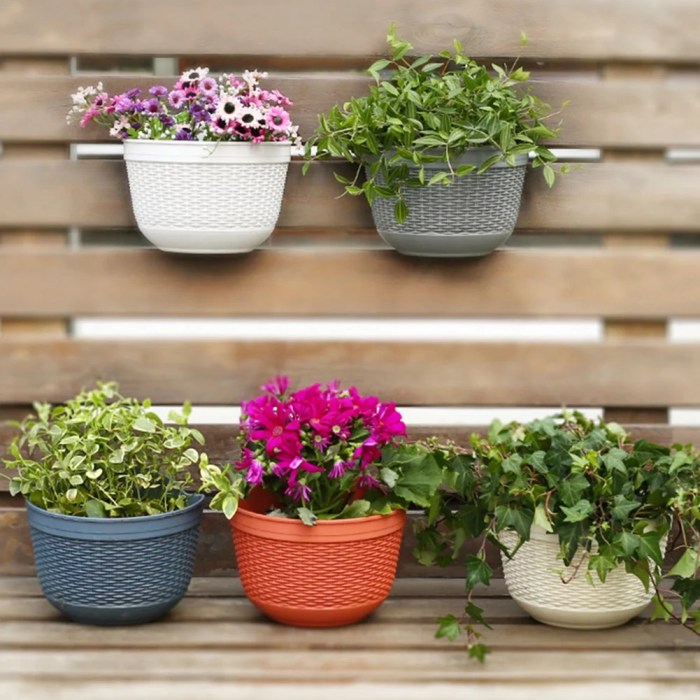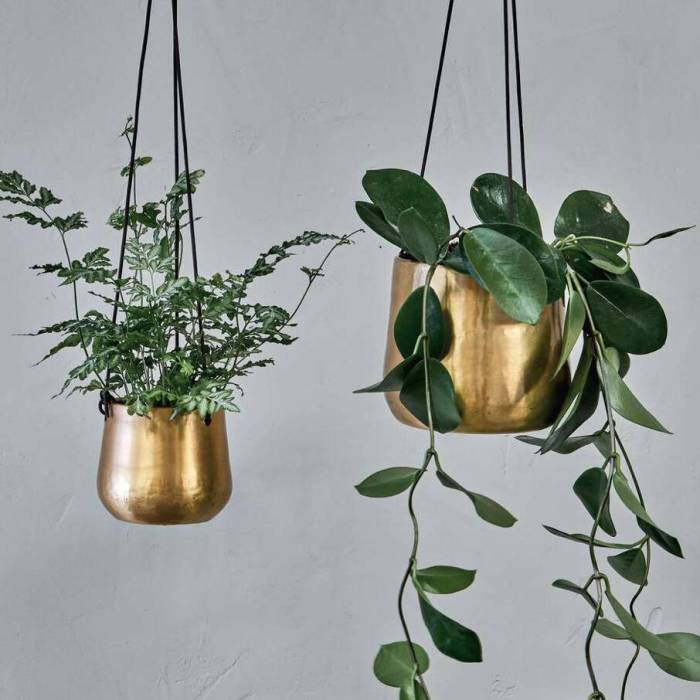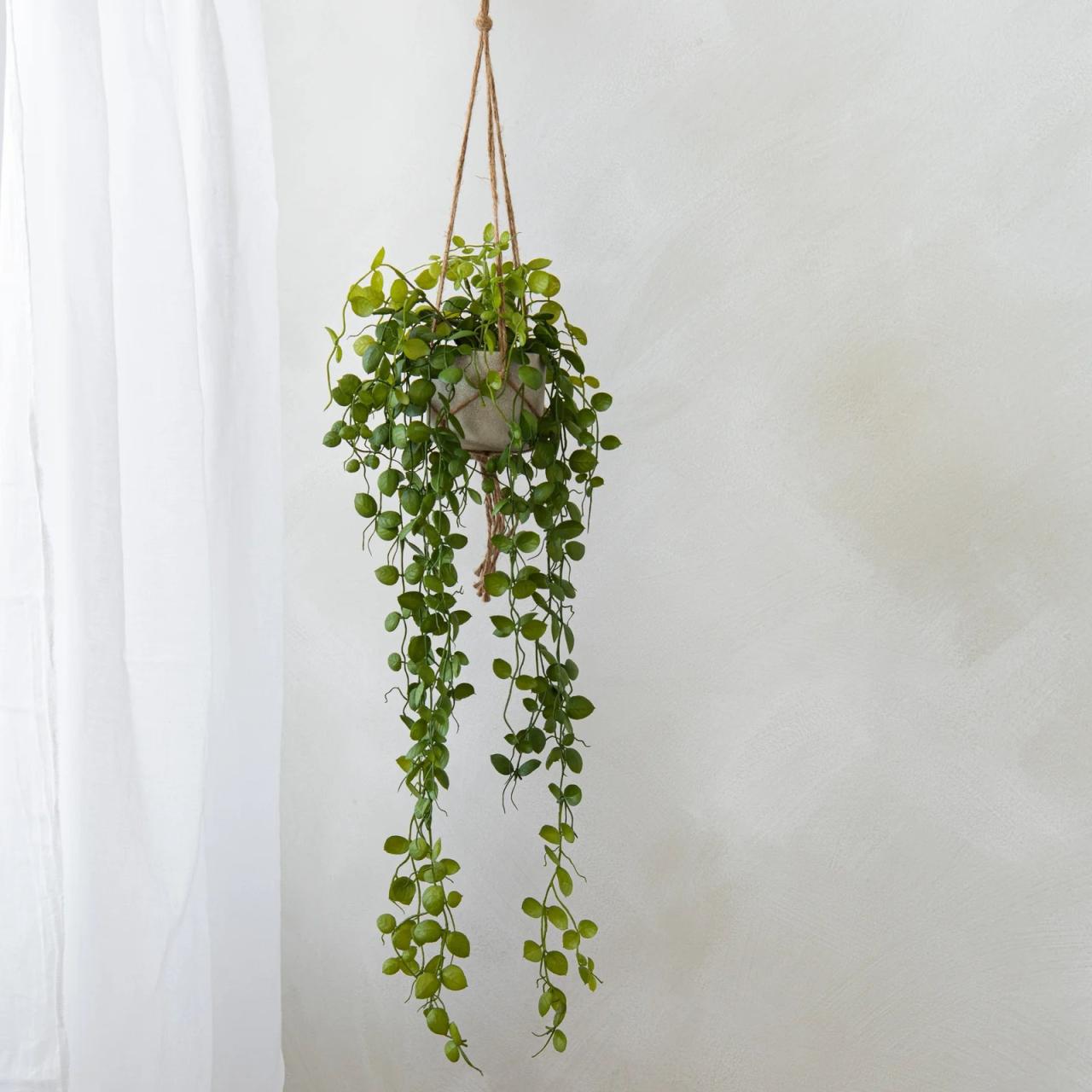Hanging potted plants are taking center stage in the world of interior and exterior design, offering a unique and versatile way to add greenery to any space. From creating lush vertical gardens to adding privacy screens and room dividers, hanging plants bring a touch of nature indoors and out.
Whether you’re a seasoned plant enthusiast or just starting out, this comprehensive guide will provide you with all the information you need to design, care for, and use hanging potted plants to enhance your living spaces.
Design Ideas for Hanging Potted Plants

Hanging potted plants have become increasingly popular as a creative and stylish way to add greenery and vibrancy to indoor and outdoor spaces. From cascading vines to lush ferns, there are countless design possibilities when it comes to incorporating hanging plants into your decor.
One of the key advantages of hanging plants is their versatility. They can be used to create a focal point in a room, add privacy to a window, or simply bring a touch of nature indoors. When selecting hanging plants, consider the size and shape of the space, as well as the amount of light available.
Hanging potted plants can be a great way to add some greenery to your home, but what if you don’t have a lot of space? Trailing plants indoor are a great option for small spaces, as they can be hung from the ceiling or placed on a shelf.
They come in a variety of shapes and sizes, so you can find one that fits your style. And because they don’t need a lot of light, they’re perfect for hanging in dark corners or hallways.
Unique Arrangements and Combinations
One of the most effective ways to create a visually stunning display with hanging plants is to use a variety of containers and arrangements. For example, you could combine a trailing plant, such as ivy or pothos, with a more upright plant, such as a succulent or orchid.
Alternatively, you could create a hanging planter by grouping several small plants together in a single container.
When choosing containers for hanging plants, consider the material, size, and shape. Terracotta pots are a classic choice, but you can also find hanging planters made from metal, plastic, or even wood. The size of the container should be appropriate for the size of the plant, and the shape should complement the overall design of the space.
Incorporating Hanging Plants into Interior and Exterior Decor
Hanging plants can be used to add a touch of greenery and vibrancy to any room in your home. In the living room, you could hang a trailing plant from the ceiling or place a group of hanging planters on a shelf.
In the kitchen, you could hang herbs from the ceiling or windowsill. And in the bathroom, you could hang a fern or other moisture-loving plant to create a spa-like atmosphere.
Hanging plants can also be used to create a welcoming and inviting outdoor space. You could hang planters from the eaves of your house, from a pergola, or from a tree branch. You could also create a hanging garden by attaching planters to a fence or wall.
Plant Selection and Care for Hanging Baskets

Hanging baskets offer a unique and attractive way to add greenery and color to your home. When selecting plants for hanging baskets, it’s essential to consider their growth habits and light requirements. Some of the best choices for hanging baskets include:
- Trailing plants: These plants have long, cascading stems that will gracefully spill over the edges of the basket. Some popular trailing plants for hanging baskets include petunias, lobelia, and vinca.
- Mounding plants: These plants form a compact, rounded shape that will fill out the center of the basket. Some popular mounding plants for hanging baskets include begonias, impatiens, and geraniums.
- Vertical plants: These plants grow upright and can add height and interest to a hanging basket. Some popular vertical plants for hanging baskets include coleus, lantana, and salvia.
Once you’ve selected your plants, it’s important to properly plant and care for them. Here are some tips:
Planting
- Use a well-draining potting mix specifically designed for hanging baskets.
- Fill the basket with potting mix, leaving about 1 inch of space at the top.
- Make a hole in the potting mix and gently place the plant inside.
- Fill in around the plant with potting mix and gently tamp down.
- Water the plant thoroughly.
Watering
- Hanging baskets dry out quickly, so it’s important to water them regularly. The frequency of watering will depend on the type of plants you have and the weather conditions.
- Check the soil moisture regularly by sticking your finger in the potting mix. If the soil feels dry to the touch, it’s time to water.
- Water the plants deeply until water runs out of the bottom of the basket.
Fertilizing
- Fertilize hanging baskets every two to three weeks with a balanced liquid fertilizer.
- Follow the instructions on the fertilizer label carefully.
Pruning, Hanging potted plants
- Prune hanging baskets regularly to remove dead or damaged leaves and stems.
- Pruning will also help to keep the plants from getting too leggy.
Troubleshooting
- Yellowing leaves:This can be caused by overwatering, underwatering, or a lack of nutrients.
- Brown leaves:This can be caused by sunburn, overwatering, or a lack of nutrients.
- Wilting leaves:This can be caused by underwatering or a lack of nutrients.
- Pests:Hanging baskets are susceptible to a variety of pests, including aphids, spider mites, and whiteflies. Treat pests with an appropriate insecticide.
Hanging Plant Structures and Materials
Hanging potted plants can add a touch of greenery and life to any space. However, choosing the right hanging structure is crucial for ensuring the safety and well-being of your plants. Various types of hanging structures are available, each with its own advantages and disadvantages.
Macrame Hangers
Macrame hangers are a popular choice for hanging plants due to their decorative appeal. Made from woven cords, they come in a variety of designs and colors, allowing you to match them to your home décor. Macrame hangers are lightweight and easy to install, making them suitable for both indoor and outdoor use.
However, they may not be as durable as other hanging structures and can stretch or break over time, especially if they are subjected to heavy weight.
Chains
Chains are a durable and secure option for hanging heavy plants. They are made from metal, which is resistant to rust and corrosion, ensuring longevity. Chains can be adjusted to different lengths, making them suitable for hanging plants at various heights.
However, chains can be more expensive than other hanging structures and may not be as aesthetically pleasing as macrame hangers or brackets.
Brackets
Brackets are a sturdy and versatile option for hanging plants. They are typically made from metal or wood and can be mounted on walls or ceilings. Brackets provide a stable base for hanging plants and can support heavier pots than macrame hangers or chains.
However, they require more installation effort and may not be suitable for all types of walls or ceilings.
Creative Uses of Hanging Potted Plants

Hanging potted plants offer a versatile and imaginative way to enhance any space, both indoors and outdoors. Beyond their aesthetic appeal, these plants can serve a variety of creative purposes, transforming ordinary environments into extraordinary havens.
One ingenious application of hanging plants is the creation of vertical gardens. By suspending plants vertically, you can maximize space, especially in urban areas with limited outdoor space. This technique allows for the cultivation of a wide variety of plant species, creating a lush and vibrant green oasis.
Privacy Screens and Room Dividers
Hanging plants can also be strategically placed to create privacy screens or divide spaces. By suspending plants from the ceiling or hanging them on walls, you can effectively block unwanted views or create distinct areas within a larger space. This technique is particularly useful in open-plan living areas or offices, where privacy and separation are desired.
Hanging potted plants can add a touch of greenery and life to any room. However, not all plants can tolerate the low light conditions that are often found in indoor spaces. For those looking to add some greenery to their low-light areas, low light hanging plants are a great option.
These plants are tolerant of low light conditions and can add a beautiful touch to any room. Hanging potted plants can be a great way to add some life and color to any room, even those with low light conditions.
Special Events and Occasions
Hanging potted plants can add a touch of elegance and charm to any special event or occasion. For weddings, they can be suspended from arches or used as centerpieces, creating a romantic and ethereal atmosphere. At parties, hanging plants can be used to decorate entrances, patios, or outdoor areas, providing a welcoming and festive ambiance.
Residential and Commercial Spaces
In residential settings, hanging plants can be used to add life and color to any room. They can be suspended from ceilings, walls, or even furniture, creating a sense of height and drama. In commercial spaces, hanging plants can enhance the ambiance and create a more inviting and relaxing environment for customers or employees.
DIY Projects for Hanging Potted Plants
DIY projects offer endless possibilities for creating custom hanging planters and unique hanging systems for potted plants. From repurposing old items to crafting planters from scratch, there are countless ways to add a personal touch to your indoor or outdoor space.
Step-by-Step Planters
Create custom hanging planters using various materials like wood, rope, and fabric. Follow these simple steps:
- For wooden planters, cut and assemble wooden boards into a box shape. Drill holes for drainage and attach rope or chains for hanging.
- For rope planters, coil and knot sturdy rope to form a hanging basket. Add a liner for moisture retention.
- For fabric planters, sew fabric into a pouch or bag with a drawstring for hanging.
Hanging Systems
Design and construct unique hanging systems for potted plants. Explore these ideas:
- Install hooks or brackets on walls or ceilings to suspend planters at different heights.
- Create macrame hangers using knotted cords for a bohemian touch.
- Utilize repurposed ladders or shelves as vertical hanging displays.
Upcycling and Repurposing
Upcycle and repurpose old items into creative hanging plant displays. Consider these options:
- Transform old baskets, buckets, or jars into hanging planters by adding rope or chains.
- Use old tires as planters by painting them and attaching hanging chains.
- Repurpose wooden pallets into vertical hanging gardens by attaching planters to the slats.
Ultimate Conclusion
Incorporating hanging potted plants into your decor is a creative and rewarding way to add beauty and functionality to your home or business. With a little planning and care, you can create stunning displays that will bring joy and vitality to any space.
Top FAQs
What are the best types of plants for hanging baskets?
Plants with trailing or cascading growth habits, such as ivy, ferns, and petunias, are ideal for hanging baskets.
How often should I water hanging plants?
Water hanging plants when the soil feels dry to the touch. Avoid overwatering, as this can lead to root rot.
How can I hang potted plants safely and securely?
Use sturdy hanging hardware and choose a hanging system that is appropriate for the weight of the plant and pot.